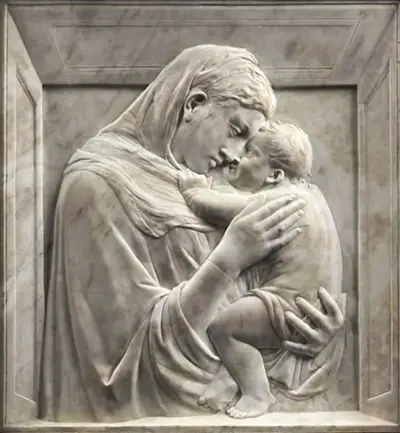 Buy Art Prints Now
Buy Art Prints Nowfrom Amazon
* As an Amazon Associate, and partner with Google Adsense and Ezoic, I earn from qualifying purchases.
Donatello’s artistic influences are widely reported to have come from his studies of ancient art and the 15th century sculptor was renowned for having a more expansive and detailed understanding of ancient sculpture than any other artist around in the same period.
Many of this works are in a bas relief style which is a shallow style of sculpture considered very innovative at the time. Born in Florence, Italy in around 1386, it is speculated that he may have learnt his trade from stonemasons at work on the cathedral of Florence from 1400 onwards, as this was obviously a huge and key monument involving a lot of skilled artisans.
The Pazzi Madonna, which dates to between 1425 to 1430 is thought to have been commissioned for private devotions and represents Donatello's later collaboration with Michelozzo, and the sculpture became excessively popular leading to copies by other artists.
The intense emotion and sombre expression of the Virgin Mary were unlike other more stylised representations of the virgin and child and seemed to depict real emotion as the mother appears to contemplate her son's later Passion as they lovingly embrace.
The bas relief technique gives an optical illusion of greater depth as the thickness of the marble gradually decreases to give the required perspective. Donatello was to become the best sculptor in this medium, working with precision and grace to create the much loved Pazzi Madonna that still enthrals art lovers and other admirers to this day.
Donatello's Early Influences
It is interesting and relevant to look at the trajectory of the sculptor's artistic impulses prior to his sculpture of the iconic Pazzi Madonna which is in the Staatliche Museum in Berlin, and what forces shaped the modelling of this work.
In around 1405 it is known that Donatello honed his skills under the tutelage of Lorenzo Ghiberti - a bronze sculptor who had become recognised for his work on the doors of the Florentine Baptistery which were in the 'relief' style of sculpture that Donatello would come to emulate in his later works including the Pazzi Madonna.
One of Donatello’s earliest sculptures, a statue of David, shows the influence of Ghiberti in in the soft, flowing lines. Other works of Donatello during this period clearly show the Gothic style pervading European art at that period, and they include a magnificent seated St John the Evangelist, also in the Florence cathedral.
Campanile Statues
By 1415 Donatello was beginning to reach the height of his powers with marble statues of St George and St Mark undertaken for niches in the church of Or San Michele, and this was followed by a set of five prophet sculptures for further niches of the campanile of the cathedral, and his figures are striking for their expressive, detailed qualities.
One particular statue is considered a masterpiece of this era - the Zuccone - from the Duomo of Florence bell tower, and the artist takes the individuality of their features from archaic Roman busts to create a forceful effect.
Relief Style of Sculpture
The earlier influences of Donatella's mentor, Ghiberti, began to be realised in Donatella's own work from 1416 onwards beginning with a marble panel of St. George Killing the Dragon which is in the Or San Michele. The technique which is known as schiacciato, meaning 'flattened out' involved a more shallow mode of carving creating the distinctive look to be seen in the later Pazzi Madonna.
In the relief style the sculpted elements are attached to the background and seem to rise out of the marble or material in an almost 3D effect. The method of achieving this visual effect is very meticulous and time-consuming, particularly the chiselling of the background. However, the degree of projection used can vary for different effects and is known as high relief, mid relief and low relief, or bas relief in the French.
After his first foray using this kind of technique Donatello was keen to explore this further and created more marble reliefs in the 1420's onwards including other religious devotional pieces such as The Ascension, with Christ Giving the Keys to St. Peter, and the Feast of Herod, both showing striking scenes and experimentations with colour.
During this era, Donatello created the beautiful and enduringly popular Pazzi Madonna which was sculpted in the low relief style, which means it has a shallow depth overall and needed less of the background chiselling away to create the desired effect.
Simultaneously the artist was branching out into bronze sculptures including a larger than life-size statue of St. Louis of Toulouse, and showing Donatello's amazing capacity for capturing the correct symmetry and proportions of the human figure even when hidden under lovingly carved drapes.



